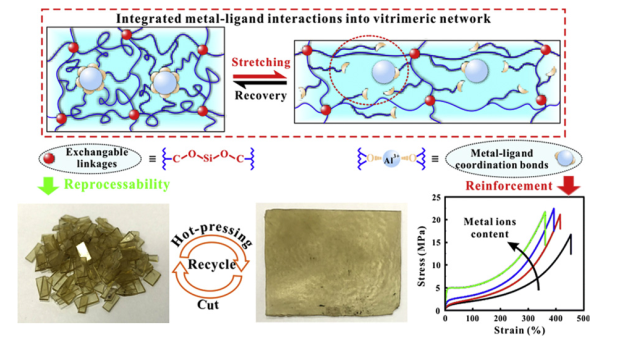| 祝贺博士吴思武在《Materials and design》 上发表文章 |
| 发布时间: 2020-07-24 浏览次数: 676 |
|
Bioinspired design of elastomeric vitrimers with sacrificial metal-ligand Siwu Wu, Shifeng Fang, Zhenghai Tang, Fang Liu and Baochun Guo⁎ ABSTRACT: Most elastomeric vitrimers suffer from mechanical weakness in practical applications. Inspired by the development of strong and tough biomaterials relying on sacrificial bond-detachment mechanisms, herein we describe the biomimetic design of elastomeric vitrimers with mechanical robustness, preservable malleability, and recyclability by engineering sacrificial metal-ligand coordination bonds into exchangeable networks. In particular, we use a commercially available metal complex, aluminum acetylacetonate (Al(acac)3), to catalyze crosslinking based on the silylation reaction between hydroxylated natural rubber and hydrosilanes, thus introducing dynamic silyl ether-based architectures into the rubber matrix. At the same time, the Al3+ ions can interact with the free oxygen-containing moieties on the rubber skeleton, enabling labile Al3+-O coordination bonds in the covalent framework to substantially dissipate mechanical energy through reversible bond detachment/reattachment upon deformation. As the organic acetylacetonate ligands of Al(acac)3 can facilitate the dispersion of Al3+-O ions in the matrix, incorporating a small amount of organometallic complex (0.68 wt% of elastomer matrix) achieves an unparalleled improvement of the strength, modulus, and toughness of the resulting vitrimers. Moreover, due to their temperature-dependent nature, the Al3+-O coordination bonds will partially dissociate at elevated temperatures, which only slightly compromises the topological rearrangements of the silyl ether-based network, but barely affects the reprocessability.
文章链接:https://doi.org/10.1016/j.matdes.2020.108756 |

